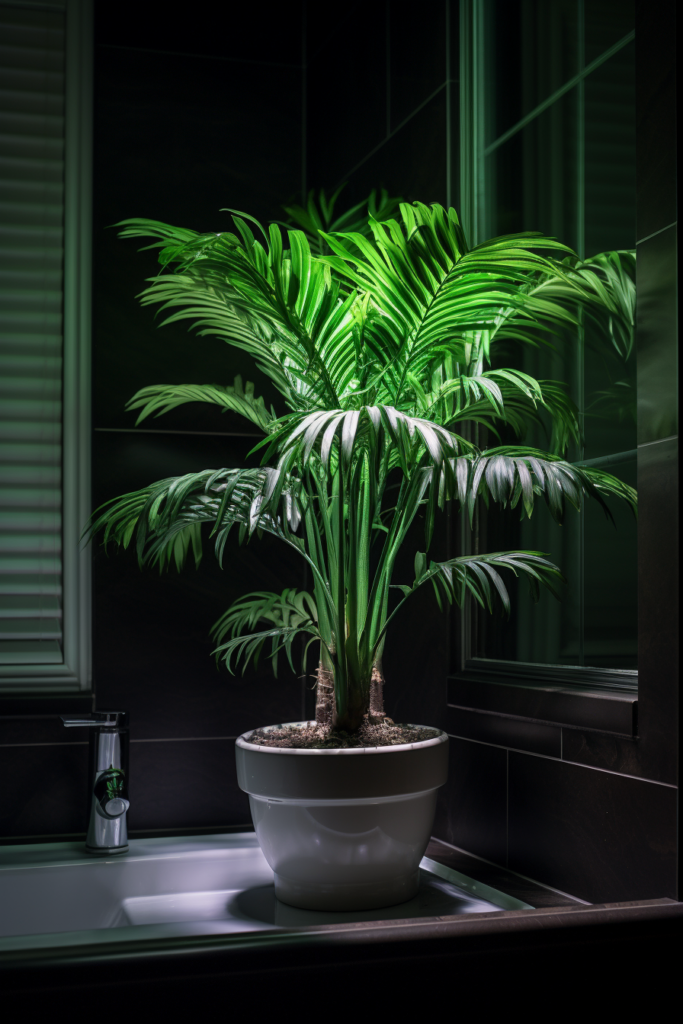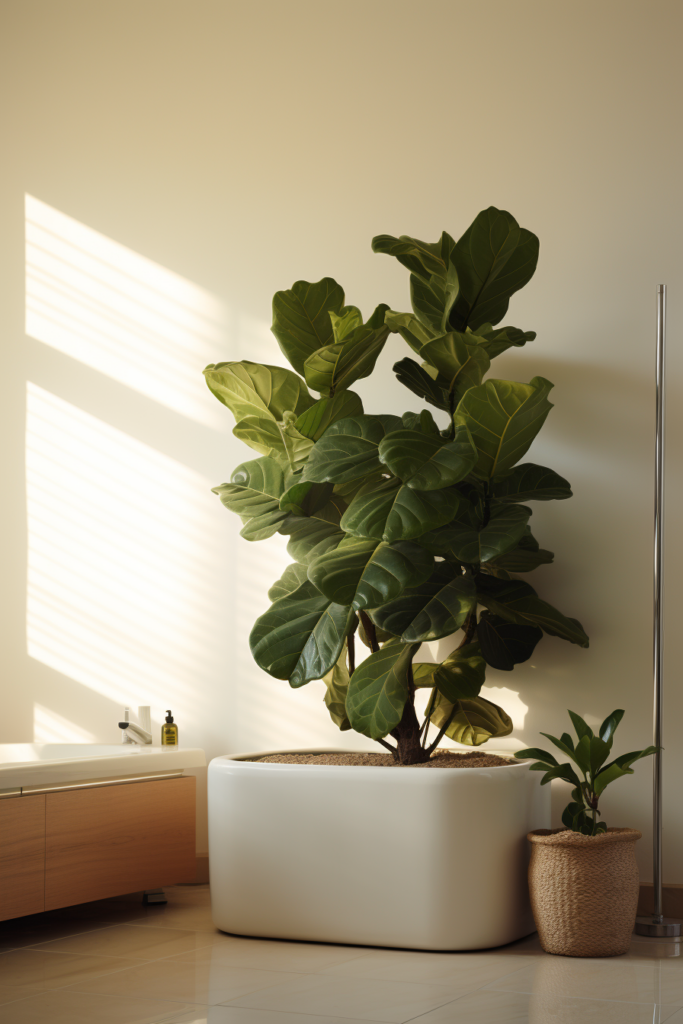
Having plants in your bathroom can add life and freshness to the space. However, bathrooms often lack adequate natural sunlight to help plants thrive. This is where artificial grow lights come in handy. With the right lighting setup, you can successfully grow lush, vibrant plants in any bathroom.
Choose Full Spectrum LED Grow Lights

The best artificial lights for indoor plants are full-spectrum LED grow lights. Unlike standard LED bulbs, these lights provide a balanced blend of color wavelengths similar to natural sunlight. This allows plants to undergo healthy photosynthesis. Full spectrum LEDs are also energy efficient and long-lasting. Look for bulbs rated between 2700K and 6500K to cover the entire light color range plants need.
- Full-spectrum LEDs mimic natural sunlight
- Allows for proper photosynthesis
- Energy-efficient and long-lasting
- Ideal color temperature between 2700K-6500K
- Provides all light wavelengths plants require
Position Lights 6-12 Inches Above Plants,

LED grow lights are most effective when positioned close to plants. For seedlings and small houseplants, mount the lights 6 to 8 inches above the top of the plants. For larger or taller plants, the optimal height is 8 to 12 inches. This focused proximity ensures light intensity is high enough for vigorous growth.
- Position 6-8 inches for seedlings and small plants
- Use 8-12 inch height for larger/taller plants
- Close proximity optimizes light intensity
- Ensures enough intensity to drive growth
- Easy to adjust height as plants grow
Run Lights for 12-16 Hours Per Day

Indoor plants need adequate daily light exposure to thrive just as they would outdoors. Run your bathroom grow lights for 12 to 16 hours per day to mimic natural day/night cycles. You can use an electric timer to automate the daily on/off schedule. Ensure the timer provides consistent lighting hours rather than varying times.
- Mimics outdoor day/night light cycles
- 12-16 hours of daily light needed
- Use an electric timer to automate the schedule
- Ensures consistent daily lighting hours
- Varying times can confuse plants
Install Adjustable Mounts

As your bathroom plants grow taller, you’ll need to raise the lights higher up to maintain the optimal 6 to 12-inch distance. Install each light on an adjustable pole mount or suspend them from adjustable hanging kits. This allows you to reposition lights vertically as required over time. It also allows angling lights towards different plants as needed.
- Allows vertical repositioning as plants grow
- Maintains ideal height above plants
- Suspend lights from ceilings with chains
- Use pole mounts placed beside plants
- Enables targeting light at specific plants
Use a Light Meter Mobile App

To accurately assess the light intensity your plants are receiving, use a light meter mobile app. These apps leverage your phone’s light sensor to measure light in lux or foot candles. Check intensity at both the top and lower leaves of each plant to ensure adequate coverage. Target 15,000 to 50,000 lux, adjusting light height and angles to optimize intensity across all plants.
- Apps use the phone’s sensor to measure lux/fc
- Check the top and lower leaves of each plant
- Verify that the full plant is receiving light
- The target range is 15,000 to 50,000 lux
- Adjust light angles and height to optimize
Combine Blue and Red Spectrum Bulbs

While full-spectrum LED lights provide balanced wavelengths, supplementing with additional blue and red bulbs can boost growth. Blue light energizes leafy growth and vegetation, while red light drives flowering and fruiting. Install separate blue and red spectrum bulbs alongside full spectrum bulbs to give your bathroom plants an extra growth kick.
- Blue light energizes leafy/green growth
- Red light boosts flowering and fruit
- Use along with full spectrum white LEDs
- Provides complete and balanced light
- Drives extra vigorous plant growth
Install Multiple Smaller Lights

A bathroom with multiple plants dotted around will need multiple light sources for full coverage. Use several smaller LED grow lights rather than one large unit. Position each light directly above or angled towards individual plants to provide personalized illumination. Use a combination of overhead ceiling lights and table or floor lamps fitted with grow bulbs.
- Use several smaller lights for full coverage
- Position directly above each plant
- Provides targeted light for each plant
- Mix overhead ceiling and portable table/floor lights
- Allows creating optimized coverage
Monitor Room Temperature

The heat output from grow lights can cause room temperatures to rise. Monitor conditions with a thermometer to ensure temperatures remain below 30°C. Excess heat stresses plants. If needed, tweak light positioning, add small fans, open the door, or run exhaust fans to manage temperature.
- Check temperature to avoid excess heat
- Optimal room temp under 30°C
- Excess warmth stresses plants
- Reposition or add fans if it is too hot
- Open the door or use a bathroom exhaust fan
Adjust Height and Angle for Even Light Distribution

Getting an even light distribution allows all bathroom plants to receive adequate intensity for photosynthesis. Assess illumination at both the top and bottom of each plant using your light meter app. Adjust the vertical height and angle of movable track lights or pole-mounted lights to distribute intensity evenly across all plants.
- Assess top and bottom of each plant
- Verify consistent lux measurements
- Adjust height until even across all plants
- Tweak angles to optimize distribution
- Allows equal light access for all plants
Recommended Bathroom Plants for Grow Lights
African violet, Saintpaulia species: This is one of the most satisfactory flowering plants for growing under lights; it grows and flowers well between 500 and 1,000 foot-candles. Light 16 to 18 hours each day.
Cast-iron plant, Aspidistra elatior: This plant needs little more than good drainage and light between 1,000 and 2,000 foot-candles to produce leaves 1 to 2 feet long.
Chinese evergreen, Aglaonema modestum: Growing best with moderate light of 1,500 to 2,500 foot-candles, this plant features lush green leaves with silver markings.
Cape primrose, Streptocarpus hybrids: Providing flowers nearly continuously if grown under 1,000 to 1,500 foot-candles, this colorful plant adds a bright pop.
Cacti: With striking shapes and blooms, cacti need about 3,000 to 6,000 foot-candles. Drainage is essential.
Cast-iron plant, Aspidistra elatior: This plant needs little more than good drainage and light between 1,000 and 2,000 foot-candles to produce leaves 1 to 2 feet long.
Chinese evergreen, Aglaonema modestum: Growing best with moderate light of 1,500 to 2,500 foot-candles, this plant features lush green leaves with silver markings.
Coleus, Solenostemon scutellarioides: The vivid red/green/yellow/pink foliage thrives with moderate light between 2,500 and 3,000 foot-candles. Pinch stems to encourage bushiness.
Gerbera daisy, Gerbera jamesonii: Providing cheerful daisy-like blooms in many colors, these plants need 4,000 to 6,000 foot-candles.
Heartleaf Philodendron: With its climbing vines and heart-shaped leaves, this trailing plant grows well in bright indirect light up to 2,500 foot-candles.
Impatiens: Preferring shade and moderate light between 1,000 and 2,500 foot-candles, these flowering plants produce delicate blooms in a variety of bright colors.
Persian shield, Strobilanthes dyerianus: Grown for its stunning iridescent purple foliage, this plant needs moderate illumination of around 2,500 foot-candles to thrive.
Polka dot plant, Hypoestes phyllostachya: Featuring vivid pinkish spots on the green leaves, the ideal range is between 2,000 and 3,000 foot-candles for vigorous growth.
Prayer plant, Maranta leuconeura: Offering patterned 6-inch leaves that fold up vertically at night, moderate light from 1,500 to 2,500 foot-candles is needed.
Spider plant, Chlorophytum comosum: As a fast grower that can reach 2 feet tall, bright indirect light up to 2,000 foot-candles helps it propagate.
Swiss cheese plant, Monstera deliciosa: This jungle vine gets large dramatic leaves if given plenty of moderate light – around 2,500 foot candles or so.
Wandering jew plants: Trailing plants with striped/multicolored leaves, optimal light is 1,500 to 2,500 foot-candles. Mist regularly.
Peace lily, Spathiphyllum: With shiny dark green leaves and unique white flowers, these thrive in moderate illumination of 1,500 foot-candles.
Pothos, Epipremnum aureum: Iconic trailing vine plant with heart-shaped leaves enjoys bright indirect light up to 2,500 foot candles.
Snake plant, Sansevieria trifasciata: Tolerating a wide range from 500 to over 6,000 foot-candles, this sturdy succulent handles both shade and intense light.
ZZ plant, Zamioculcas zamiifolia: Distinguished by shiny, plump leaflets, moderate light between 1,500 and 2,500 foot-candles keeps this low maintenance plant happy.

Conclusion
By following these artificial lighting strategies tailored for bathrooms, you can successfully grow lush plants that would normally struggle in dark, enclosed spaces. The right full spectrum grow lights properly positioned provide everything your botanical bathroom buddies need to stay green and thrive indoors. Be sure to monitor and adapt your setup over time as plants grow and conditions change. With a dialed-in lighting system, your bathroom sanctuary will flourish with healthy, vibrant plants.
Follow Quiet Minimal on Pinterest for more home design tips and inspiration.


